“Our Man Bashir”
Written by Bob Gillan and Ronald D. Moore
Directed by Winrich Kolbe
Season 4, Episode 9
Production episode 40514-482
Original air date: November 27, 1995
Stardate: unknown
Station log: A man with an eyepatch, who is called Falcon, goes flying through a plate glass window. The man who threw him through it is Bashir, wearing a tuxedo. He is handed a glass of champagne by a grateful woman in a red dress. Bashir sees Falcon get up in the reflection of the bottle, and pops the champagne cork right at his forehead, knocking him unconscious. “A lot of kick for a ’45 Dom,” he says before kissing the woman.
The smooching is interrupted by Garak, who is also wearing a tux, and who is intrigued by this program of Bashir’s. Since he got it, he’s spent all his spare time in the holosuite, and he won’t tell anyone about it. Garak convinces Bashir to let him stick around and observe his fantasy.
However, the woman in the red dress leaves. Garak realizes that he probably scared her off, and apologizes, saying that Bashir has every right to be so angry with Garak that he should take a champagne bottle and shoot him. Bashir figures he’s going to regret this, but Garak asks the question no one should ever ask under any circumstances: “What could possibly go wrong?”
They fly from Paris to Hong Kong, where “Agent” Bashir keeps a lavish apartment. Garak sneers at the décor, but Bashir says it’s apropos for 1964. His valet, Mona Luvsitt—who wears a miniskirt and shows significant cleavage, but who also has a degree in biology, speaks seven languages, and mixes a mean martini—takes care of his things. Garak is appalled to learn that Bashir’s character is not a rich dilettante but a spy—his government, Great Britain, provided the apartment, his weaponry, the valet, and more. Garak mutters that he joined the wrong intelligence service…
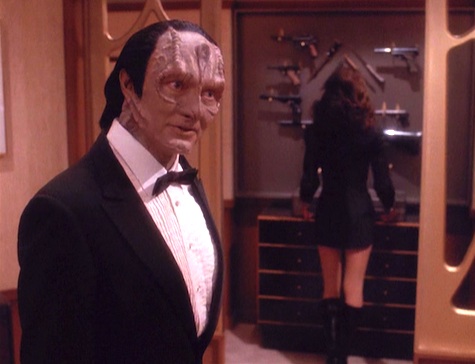
Back in the real world, Sisko, Kira, Dax, Worf, and O’Brien are returning from a conference in the Orinoco. Someone sabotaged the runabout and it explodes just as Eddington is beaming them off. The transporter is damaged, and the five patterns are in the buffer. They have to store their patterns somewhere before the patterns degrade. Eddington has to store their neural patterns in the computer, which he can only do after wiping the entire computer memory of the station.
On the holosuite, a secret chamber with a bed behind the bar has an unexpected occupant: Kira. Except it quickly becomes apparent that it’s not Kira, it’s Colonel Anastasia Komananov, one of the characters in the program—but she now looks like Kira, with the computer insisting that this is the proper image for Komananov. Bashir and Garak contact Ops, and they soon realize that the neural patterns of the runabout crew are in the station computer, but their physical forms are in the holosuite, replacing the characters in Bashir’s program. Odo and Eddington tell Bashir that he has to keep the program running and not leave the holosuite, otherwise they risk losing all five of them.
Komananov is there on business, not just to flirt with Bashir. There have been several artificial earthquakes all across the globe, which all happened after a seismologist named Honey Bear disappeared. Komananov’s dossier on Bear includes a picture: it’s Dax, wearing large glasses. Bashir and Garak (and Komananov) have to rescue Bear, because if she’s killed, the computer will erase her image, and they’ll lose Dax.
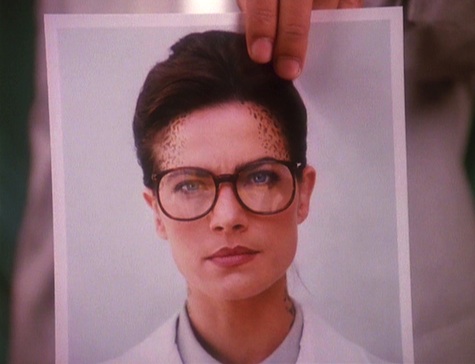
Before they can continue, Luvsitt is killed by Falcon—who now looks like O’Brien. Falcon grants Bashir and Komananov one last kiss. She whispers, “Earring,” and Bashir grabs the earring and tosses it to the ground—it’s a flash-bang, and it disorients Falcon and his two henchmen enough for Bashir, Garak, and Komananov to take them down—though Bashir has to stop Komananov from killing Falcon, which would kill O’Brien. Garak is also bleeding, meaning the holosuite’s safeties are off.
Garak cautions Bashir that he may not have the luxury of saving everyone. Real spies sometimes have to make life-or-death decisions, but Bashir will cross that bridge when he comes to it. Their only lead is that it might be Dr. Hippocrates Noah who kidnapped the scientists. He’s kidnapped some other people, apparently from Club Ingenue in Paris. So off they go…
Odo and Eddington get Quark and Rom to open up the holosuite controls, and Eddington confirms that all five images are there. They just have to figure out how to reintegrate their neural patterns with their physical forms. Eddington suggests using the Defiant, but Rom will need to make some modifications to make his equipment compatible with Starfleet’s. Rom sets up massive wires and tubes and such, causing Eddington to mutter that O’Brien’s going to kill him when he gets back.
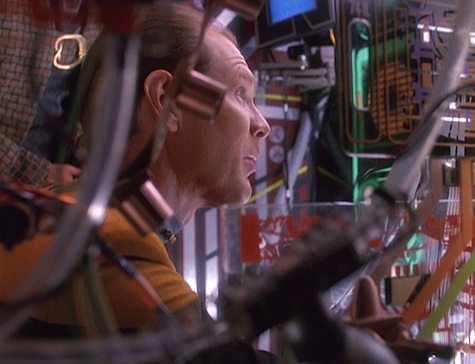
Back in their tuxedoes, Bashir and Garak, joined by Komananov enter Club Ingenue, which has gambling, drinking, and go-go dancers. Dropping Dr. Noah’s name gets them brought back to the baccarat table, run by a man named Duchamps—who looks like Worf. Bashir claims to be one of the world’s finest geologists, and feels insulted that Noah invited other top scientists and not him. Duchamps says a meeting can be arranged for 5000 francs, which Bashir then proceeds to win at the baccarat table. Duchamps then takes out a cigar and gasses them.
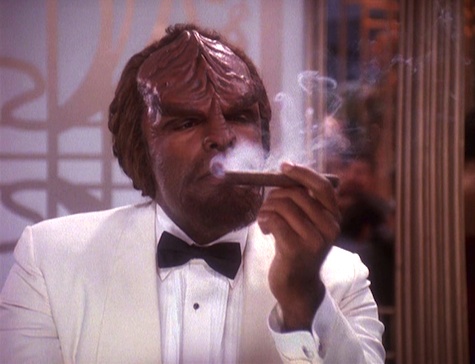
They wake up in a lavish sitting room atop the Himalayas. They are greeted by Noah—who looks like Sisko. Noah claims to believe in an orderly world. He’s building a new future, a new beginning for humanity, right here on his island. Bashir is confused by his calling a mountaintop an island. The earthquake sites, Noah reveals, were all tests for a massive set of lasers that will cause massive earthquakes that will be enough to flood the entire world, except for this mountaintop, the highest in the world. All that will be left of humanity are the people Noah has gathered, the finest minds on Earth, who will repopulate the human race.
Noah also knows that Bashir isn’t really a geologist, because his chief of security is Falcon, who blew his cover. Bashir and Garak are tied to two posts at one of the laser sights. Once it fires, they’ll be drowned in lava.
Bear shows up to check the readings one last time. Bashir, knowing precisely what era he’s pretending to be in, compliments Bear on her beauty, convincing her that the last thing he wants to see before he dies is her with her glasses off and her hair down. She is, of course, smitten, and gives him one last kiss—as well as the key to the handcuffs. Garak, who has been making snide commentary all along, says, “Kiss the girl, get the key—they never taught me that in the Obsidian Order.”
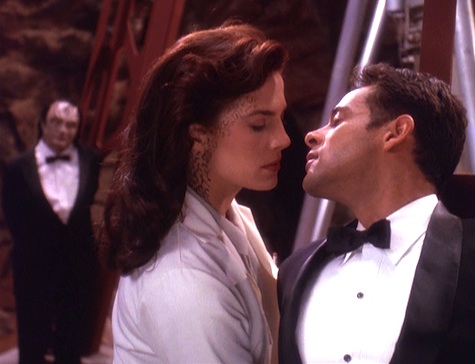
They escape just as the laser is fired up. Bashir assembles a tiny handgun from stuff stored in the heel of his shoe, because of course he has a gun in his shoe, and says they have to go to the control room. If the program plays out as planned, either Bear or Komananov will be killed, with the other ending up with Bashir. He can’t let that happen.
Garak, however, is done with all this. It’s time to cut their losses. A real spy would get while the getting’s good—that’s how he’s stayed alive all these years. But Bashir won’t sacrifice the crew—and when Garak tries to call for the exit, Bashir surprises Garak (and the viewer) by shooting him. It’s only a flesh wound to the neck, but Garak is impressed enough to not call for the exit and follow Bashir’s lead. (“Who am I to argue with Julian Bashir, secret agent?”)
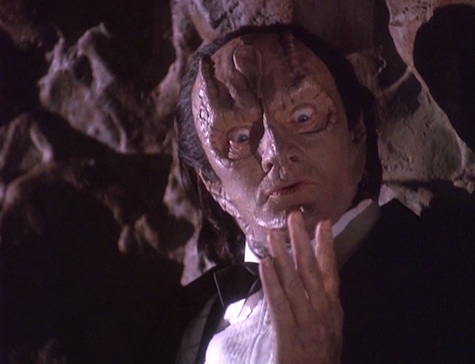
Bashir and Garak burst into the sitting room and free Komananov (Noah’s keeping her alive as breeding stock)—but then Duchamps comes in and gets the drop on Bashir and Garak. Eddington calls Bashir and tells him that they’ll try beaming everyone out in two minutes, so he has to stall.
Which he does by capitulating, by saying that he has no place in Noah’s new world, and then he uses the same words Garak used on him to Noah about cutting his losses (while an appreciative Garak looks on). And then Bashir pushes the button and destroys the world.
Odo transfers the neural patterns to the Defiant and Rom is able to beam the physical patterns off the holosuite and reintegrate everyone. Naturally, the first thing O’Brien says is, “What’d you do to my ship?!”
Back on the holosuite, Bashir and Garak head out, but Bashir assures Garak that Julian Bashir, secret agent, will return….
Can’t we just reverse the polarity? As established inTNG’s “Relics,” transporter patterns degrade if they’re kept in the buffer for too long (which is a handy way of explaining why they don’t just store people in the buffer all the time), so Odo and Eddington need to dump the neural and physical patterns somewhere. Rom also apparently has to juryrig a lot of the equipment for the holosuites because Quark is too cheap to get top-of-the-line parts.
The Sisko is of Bajor: Sisko’s image is used for Dr. Noah, complete with Nehru jacket, cigar, and over-the-top acting. The only thing missing is a cat to pet.
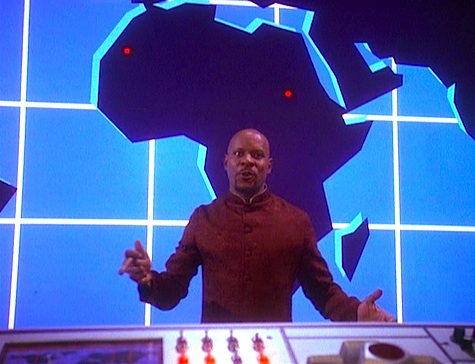
Don’t ask my opinion next time: Kira’s image is used for Komananov, who’s a Soviet agent, but still sleeps with Bashir, an enemy agent. She has a hilarious Russian accent that’s missing only a query for the whereabouts of moose and squirrel.
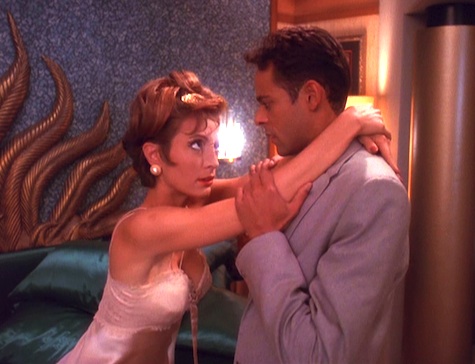
The slug in your belly: Dax’s image is used for Honey Bear, the seismologist who hides her beauty behind a pair of glasses and pinned-up hair. It’s actually kind of amusing, given the concerns that some (including your humble rewatcher) had about Terry Farrell during the show’s first season, that she was all good looks and wouldn’t be convincing as a scientist. While Farrell put those concerns to rest by the second season, it’s amusing to see her in this role here.
There is no honor in being pummeled: Worf’s image is used for Duchamps, Noah’s associate who gets to suavely kidnap scientists while wearing a white tuxedo and smoking cigars.
Preservation of mass and energy is for wimps: Odo, along with Eddington, has to try to save the five trapped crew.
Rules of Acquisition: It’s Quark, oddly, who figures out that the neural patterns of the crew are stored in the station computer, after Rom reminds everyone that holosuites can’t store stuff at the quantum level and so can’t store the neural energy, just the physical forms.
Plain, simple: Garak pretty much forces his way into the program—starting by cockblocking Bashir with the blonde in the red dress—and is disdainful of the entire exercise, making copious snide commentary along the way about the lack of realism compared to the real life of a spy (something Bashir throws back in his face right before he shoots him), not to mention the sexism and the awful décor. (He’s particularly disdainful of the décor, mentioning it several times.)
For Cardassia! The Orinoco was sabotaged by the True Way, a Cardassian separatist group who is against the treaty with Bajor and blames the Federation for all their economic woes.
What happens on the holosuite stays on the holosuite: You gotta be grateful that Bashir wasn’t running, say, the program of Nog’s that Dax gave him before he left for the Academy. As it is, Bashir’s been doing the secret agent thing in pretty much all his off-time since he got the program.
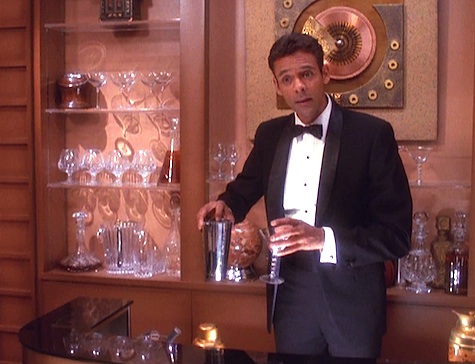
Also, Quark’s holosuites have safeties that can be disengaged. This made no sense on the Enterprise, and it makes even less sense in a commercial holosuite, where the safeties being disengaged can lead to serious consequences for Quark if one of his customers gets hurt. The safeties should be hardwired.
No sex, please, we’re Starfleet: In the program, Bashir is sleeping with Komananov, tries to sleep with the blonde in the red dress, probably is sleeping with Luvsitt (because if he’s not sleeping with his cleavage-y, leggy valet, it would violate the tenets of the program, honestly), and seduces Bear in a manner that could only be accomplished by a male in 1960s fiction.
Keep your ears open: “Where’s the core memory interface?”
“Oh—it’s right behind the spatula.”
Eddington and Rom in an exchange that perfectly sums up Rom’s engineering methods.
Welcome aboard: The main guests in this are recurring regulars Andrew J. Robinson as Garak, Kenneth Marshall as Eddington, and Max Grodénchik as Rom. In addition, Melissa Young and Marci Brickhouse play the two beautiful women Bashir interacts with who aren’t members of the main cast.
Trivial matters: This episode is, obviously, an homage to 1960s spy stories, with James Bond being the most obvious, but also using elements of The Man from U.N.C.L.E., Our Man Flint, The Wild Wild West, and Matt Helm. But the strongest is Bond, from Bashir introducing himself by last name and then full name, to Dr. Noah—a play both on Dr. No and on the biblical character who survived the great flood—to tons of tropes, ranging from the bad guy describing his plan in great detail, to the death trap that’s easily escaped from when shooting him would’ve been more efficient, to the notion that one of the two women in the story will die while the other winds up with the hero, to moving the plot along by the hero winning at a card game, etc.
The episode took nine days to film; a typical DS9 episode took seven, but several of the stunts and sets took a lot longer than usual to set up.
While the program will be mentioned—in “A Simple Investigation,” “Change of Heart,” “His Way,” and “It’s Only a Paper Moon”—it won’t be seen again, mainly because the studio got a sternly worded letter from MGM, the owners of the James Bond movie franchise. While there was nothing specifically actionable in “Our Man Bashir,” it came close enough that they didn’t want to risk it in a subsequent episode. (Ironically, one of the Bond homages was Bashir’s line at the end that he would return, a play on the card at the end of the Bond films that James Bond, 007, would return, and it was partly because of that that he wouldn’t…)
The True Way will be seen again in “Crossfire.”
This episode got two Emmy nominations, for Outstanding Hairstyling and Outstanding Music Composition.
Walk with the Prophets: “Bashir. Julian Bashir.” There really isn’t a lot to say about this episode. “Little Green Men” wore 1950s B-movies on its sleeve and “The Sword of Kahless” wore The Treasure of the Sierra Madre on its sleeve; this episode wears 1960s spy movies on the whole damn shirt. (Kudos to Jay Chattaway, whose music is spot-on for the time period.)
But holy crap is it fun. All the actors take great glee in their roles, though as is often the case, Avery Brooks and Nana Visitor are the standouts. Both leave no piece of scenery unchewed, the former with his delightful histrionics that put him right up there with Gert Fröbe and Joseph Wiseman and Donald Pleasance and Christopher Lee and Javier Bardem, the latter with her hilarious accent that nonetheless never wavers. She also gets the most to do, since she’s alongside Bashir and Garak for much of the story. (I particularly love her plaintive cries of “Who is Dax?”)

Even the technobabble, which is so incredibly contrived, is at least ameliorated by the hilariousness of Rom’s homespun engineering (I don’t think I’ve ever laughed so hard at any line in Star Trek as I did at Rom’s “behind the spatula” line).
Not much to say here: it’s a romp, and even though it gets serious for half a second when Garak lectures Bashir about how real spies are supposed to behave, it never ceases to be a fun romp that lets the actors play around a bit. I mean, sure, there’s stuff you could analyze about this episode, but there’s little point, as it’s all an excuse for everyone to have fun. Sisko chewing scenery along with his cigar! Kira’s absurd accent! Worf in a tux! What’s not to like?
Warp factor rating: 9
Rewatcher’s note: Keith is in the home stretch of his Kickstarter for a new story in the Dragon Precinct universe, featuring the characters of Gan Brightblade and his friends from that novel. He hopes you’ll support it—just two bucks will get you a copy of the story itself! If we reach $2500 there’ll be cookies! It ends on Thursday evening. Details can be found here.
Keith R.A. DeCandido will be part of a talk on the ins and outs of writing media tie-ins at Housing Works Books and Café as part of their “Geek Week” on Wednesday at 7pm. He’ll be joined by fellow novelist David Mack, editor Ginjer Buchanan, and moderator Cici James of Singularity & Co. Full details here. Come on by!










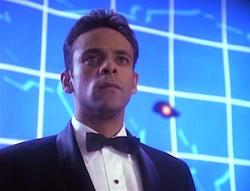
Given that MGM had a problem with the Bond stuff, would this maybe be why we later got the Vic Fontaine program? It let the producer’s play with Bashir’s 1960’s fetish, without treading too much on Bond territory?
A 9???????
After this episode was over, I turned to husband and said, “That is the WORST thing I have ever seen!” Like, this might actually be worse than Q-pid and that episode where everybody devolves because of the T-cells in their DNA (I am completely blanking on the title). The only thing that gets it to maybe a 2 or 3 is, a)the cast clearly having fun chewing the scenery and b)Garak getting to snark about what a spy’s life truly is. And I feel like we’ve already gotten quite a few episodes where the cast get to have fun playing different characters, so, honestly, I’m over that gimmick now.
But…ugh…not a fan of Holosuite episodes, usually not a fan of ‘alternate setting’ episodes (and I’m not that into the whole Bond thing to start with), and this was basically Bashir at his very Bashir-iest.
I mean, at least Qpid had John de Lancie…by the way, hope you had fun hanging with him!
Generally speaking I hate “the holodeck safeties are off” episodes, but I make a huge exception for this one. Like with “Little Green Men” a fondness for ridiculous 60s spy fiction really helps and this episode may hit even more marks than LGM did with its genre. (And krad missed one obvious homage which is right there in the title. Namely Our Man Flint which was half parody itself.) It’s a fun hour and it’s easy to just sit back and enjoy. OTOH, it might have been better coming after a bit of a serious stretch, rather than the third in a run of lighter episodes.
Of course, Garak’s running commentary and comparison with real spycraft does provide a bit of serious tone. He’s not in the least bit wrong about any of it, either. I wonder what he’d think of George Smiley.
I bet they could have gotten away with doing more of this. As noted, this was an entire genre, and just because Bond had more staying power doesn’t give MGM the rights to the whole thing. But they were probably still a bit gunshy from the Holmes debacle.
Lisamarie: I adore this episode. *shrug* And the one you can’t remember the title of is “Genesis.” :)
And I didn’t really get to hang with deLancie — I honestly barely saw him.
—Keith R.A. DeCandido
DemetriosX: I did too mention Our Man Flint, right there in the first Trivial matters paragraph….
—Keith R.A. DeCandido
No problem, I am probably not the target audience for this episode ;) After all, I’m sitting here at a software company wearing duct taped glasses, snow pants, a sweatshirt and with my hair in a messy ponytail. Clearly, people here only love me for my mind ;)
You can spot Ira Behr’s footprints and love of old-school Hollywood all over this first half of the fourth season.
Much like Little Green Men and Sword of Kahless, this is the kind of episode that would never have been made back under Michael Piller’s leadership. This is much more suited to Ira’s sensibility.
This is also the episode that actually improves with repeated viewings, especially after having seen a lot of Bond or other flamboyant action/spy films.
When I first saw the title for this episode, back in 1995, I actually thought they were going to kill Bashir off for good. “Our Man Bashir” really sounded like a post-mortem eulogy.
Yo, KRAD: you mean Gert Fröbe, not Gert Forbe!
I love this episode (I guess I am the target audience) – it is just so silly – it’s really a breath of fresh air before all that is to come in the next couple of seasons.
Oh and tell your fiance to warm up the oven :)
Yes, well worth it just to see Worf in a tux! And damn the 24th century aversion to smoking. Our favorite Klingon needed a stogie in every episode, especially in combat.
By the way, ever notice how smoky some of the Klingon ships are, like the Bird of Prey in The Search for Spock? Come on, you know those guys stopped by planet New Cuba on the edge of the Neutral Zone before heading to Genesis. Or New Amsterdam…
DrPedantStrikes!: good call. That’s what I get for relying on memory instead of the Internet. :)
—Keith R.A. DeCandidod
Lisamarie: While I wouldn’t go so far as to say it was the worst, this isn’t an episode I particularly cared for. Not having seen any Bond movies may account for it.
Ironic that Garak should be the advocate for the harsh realities of the real spy business, given that Andrew Robinson’s entire characterization is basically an ongoing impression of Robert Vaughn as Napoleon Solo in The Man from U.N.C.L.E., one of the least realistic spy shows of all. (Solo was created by Ian Fleming, so he was very much from the same cloth as Bond, although more like the later Roger Moore Bond than one of the more serious ones.)
This was a fun ’60s pastiche, but oh, the technobabble setup is agonizingly absurd. I’m not crazy about the assumption that the physical pattern of a living being is equivalent to that of a holodeck character. I mean, holodeck characters are just humanoid forcefields with patterns of light projected onto their surfaces. They don’t have internal organs and cellular structure and whatnot.
I love this episode because it is light, fluffy, entertaining and just a party end to end. I have never really been a Bond fan, but this is just so much *fun*. Garak is the very best, and his snide comments along the way make this all so watchable. Kira’s horrible Russian accent is most amusing. I totally ignore the technobabble on this one – it just makes me smile.
Just a minor correction: you do see the holoprogram again in A Simple Investigation, but only very briefly. There was a short scene where Odo pops in on Bashir in a limo, and when he leaves O’Brien (playing Falcon) reveals himself as the driver with a gun on Bashir.
Mona Luvsitt played by Marci Brickhouse. That’s just mighty mighty.
This reminds me a lot of ‘Zero Sum Game’ by David Mack (2010). At the time I read it last year I wrote in my review:
Not really a science fiction story, more like Dr Bashir is James Bond in space (or maybe Max Smart given some of the ridiculous situations he escapes from). It feels to me like something Edmond Hamilton would have written in the 1930s. However it is very entertaining and sets up the situation for the following books.
So it’s not the first time Bashir has been a “spy”.
@krad, so you did. I blame late hours and lack of sleep. Somehow my eyes went from UNCLE to Wild, Wild West.
This is where Garak really starts trying to teach basic spycraft to Bashir. He’s done so a little bit before, but seeing this wholly unrealistic version seems to motivate him. Good thing Julian proves to be an apt pupil…
Another one in the target audience. But, I grew up on Bond. The flavor is harshly different from Homefront and the following arc, which I find good and bad. It makes the series more fun, but it does pull you out of the story a little. Still, the good of doing so outweighs the bad.
The cookies are tempting,..
A great fan of this episode and, having grown up with Bond, U.N.C.L.E and all things Spy-Fi, it could have been made with me in mind; especially as I was telling friends during Season One that the lad playing the doctor would make a great James Bond in about ten years time.
The holosuite plot doesn’t particularly bother me, it’s a device to enable the story and Rom’s improvised repairs are great. And a definite thumbs up to Jay Chattoway’s music. A great pastiche of the John Barry soundtracks.
With my Bond fan hat on, a curious thing is that this episode gently parodies the evil plot to end life on earth and re-start with a new specially chosen breeding stock. This is widely thought to be a generic Bond plot, but only occurs twice in two consecutive films, The Spy Who Loved Me and Moonraker. And ironically, these are from the Roger Moore era and were made in the rather fashion-challenged 1970s, not the ultra-cool ’60s. Bond fan hat off.
Though some of the tech in this episode strains credibility, I did like the rare acknowledgement that the ships (in this case, the Defiant) had independent power and computers and such. Though the novels remember it now and then, all too often in the shows when comms are disabled or the transporters are down, no one thinks to go use a runabout.
Otherwise, a cheesy but fun episode.
-Andy
Isn’t it funny how Trek can’t seem to do a holodeck homage without the object of the homage getting upset? If it’s not Sherlock Holmes and the Conan Doyle estate, it’s James Bond and MGM.
@22
Vic Fontaine’s program seemed to do alright on a continuing basis, and without the estate of Frank Sinatra breathing down Paramount’s throat.
@23: That’s probably because James Darren and Frank Sinatra were good friends.
@13, Christopher – you just blew my mind. I thought I knew pretty much everything about trek but I have never heard of or noticed the similarity between the portrayal of garak and robert vaughn before.. wow, I can really see it now.
@10
Work smoking a cigar in a white tux is pretty flipping awesome.
I’m halfway between @Lisamarie and @krad here. I didn’t hate it, but it’s far from being one of my favorites. The whole transporter malfunction technobabble contrived just to get the main cast into the holosuite program with real consequences was just too forced. It just threw me right out of the story. A holosuite malfunction due to Quark’s cheap maintenance would have been more believeable, perhaps with the ops crew in another suite for some valid reason to explain their presence in the story.
But … it was indeed fun to watch. As a 20 something male (when this first aired) I quite enjoyed seeing Terry Farrel and Nana Visitor get to vamp in these 60’s spy movie roles. ;)
As a James Bond fan, I loved this episode. Though a few things stick out to me: The two kisses.
Recalling from the review of “Fascination” that Visitor and Siddig were in a relationship, the kiss between Bashir and “Anastasia” was amusing, but the kiss between Bashir and “Honey” was more awkward to watch, especially given the developments of “Starship Down”. (Ironic, considering the first kiss was filmed to look like it was supposed to be awkward…)
The kisses themselves don’t really bother me, though, but what most sticks out to me is the current lack of discussion about said kisses, considering that CLB called “Through The Looking Glass” “voeyeristic” and “macho wish fullfilment”. Granted, Bashir didn’t go quite as far as Sisko did in that episode, but, again, I find the lack of discussion peculiar.
@28: I think that kissing a forcefield projection that resembles a person you know is very different from having sex with a flesh-and-blood alternate-timeline counterpart of the actual person. Particularly having sex with them by impersonating someone you’re not, which arguably constitutes rape by deception.
Well, I loved this episode. It is just sooo much fun, the hightlight (for me) being Avery Brooks’ portrayal of Dr. Hippocrates Noah. You can tell Brooks is really enjoying himself, and I can’t help but smile when I watched Brooks portraying the mad scientist. Just a damn fun hour, not much more to say for this one.
Krad, according to the subtitles and to Memory Alpha, the character’s name is spelled “Honey Bare.”
And I wouldn’t exactly say the audience was surprised by Julian shooting Garak…I think the ending of that confrontation was seen a mile off.
I did like the music in this episode…both the James Bond spy notes, but also how the action music at the end had bits of the Deep Space Nine theme in it.
I guess I didn’t really like the whole contrivance for getting the characters in there, though. Obviously they did it this way rather than a holodeck malfunction a là “A Fistful of Datas” was to give tension and consequences to the whole thing…but it just seemed a little silly and contrived and rushed. Even though this terrorist group may be mentioned later, we don’t get the sense that there’s any followup there from this episode…it all just seems rather handwavey since the whole plot only exists to get them into the holodeck.
I also feel that for an episode where the characters were supposed to act out of character, Dorn kind of dropped the ball. He just reminded me of Worf trying to go along with the part of Duchamps. If the neural energy is elsewhere in the computer, the characters shouldn’t act like the crew at all. I think Dorn did a lot better being a different character in “Far Beyond the Stars.” I also thought it was ridiculous that Garak called for the doors by starting this really long and complicated sentence like, “Show me the mechanism by which…” almost as if he were trying to give Bashir extra time to shoot him. Though I think it would’ve been amusing if when they were discussing calling for the doors while tied up, the computer interpreted that as a call for the doors.
A fun episode, to be sure, but not willing to give it a 9 just because of some fun (plus I’m not sure if I’d want to rewatch it). Even episodes that are excuses to have fun should hold up within themselves, and within the context of a show that’s meant to be taken seriously in every other episode.
I’d give this one about a 7 myself. It’s fun and does a great homage to all the 60’s spy movies and tv of that era. I agree with all of Garak’s snarky comments about how a real spy would behave to get the job done. Everyone has a blast chewing the scenery and Rom gets to show off too. I just don’t really need to re-watch the episode.
I find it more believable that Quark’s holosuites would have safeties that can be overriden or switched off than the Federation. Quark has either Ferengi or Cardassian holosuites (depending on whether they are station equipment or his own), neither cultures are big on safety. Plus Quark has customers who sometimes like to get hurt, Klingons, BDSM enthusiasts, Chief O’Brien (proper safe-safeties would prevent all those holosuite-kayaking injuries), and who knows what others. He can charge more if he turns the safeties down or even off. All he has to do is put a standard “your relatives can’t sue me if you die” clause in his holosuite rentals agreements.
It is the risk averse Federation who ought to have hardwired holo-safeties. The fact that they don’t suggests that it might not even be technically possible.
@33: Holosuite/deck safeties have never been shown to prevent all injuries, just life-threatening ones. We saw Dr. Crusher treating a few people for holodeck sports injuries over the years.
It only occurred to me while reading this review that Worf gassing Julian and Garak seems like part of the program and not a “holodeck safeties are off” glitch. I know, there’s so much more to nitpick in this episode, but I find it funny to think that people in the Trek universe might accept that as part of a typical night’s entertainment.
@35 Sanagi
Actually, that strikes me as a good way to deal with a scene change without losing verisimilitude. Rather than having either a lengthy plane ride where nothing happens or whatever the holo-equivalent of a load screen is, you get a moment of apparent unconsciousness and then you’re in a new location.
I actually agree this is a good – and fun – episode, but you do realize that by giving it a 9 you’re relinquishing any rights to complain about nonsensical technobabble plots in the future, right?
BOOOO at MGM. Seriously, it’s not like Paramount and Siddig were going to use this episode to launch a competitor series to James Bond. They weren’t threatened in any way by this; they should have just been glad that their franchise is still apparently generating spin-offs in the 24th Century. :P I hate when companies get like this.
I’ve lived in Russia, and Visitor’s accent was … not bad, actually. Exaggerated, sure. But pretty realistic, by TV standards for non-native-speaking actors. (And TV standards, in turn, are worlds ahead of Chekov standards. Sigh.)
I’ve only probably seen 6 or 7 of all the Bond movies ever made, but I can still enjoy this episode. It’s not the best of Trek, but it’s fun. :)
@13: Well, there’s really no conflict between this and the theory that Garak ACTS like a terrible spy all the time, on purpose. (I think I picked up that theory from this re-read, right?)
@28: In my book, kissing vs. sex makes a HUGE amount of difference …
@33: My thoughts exactly.
Oh yeah, and ROM WINS. Spatula. Heh.
@33&34 – I always assumed that the point of the holodeck safeties was that it would prevent the holodeck characters or situations from harming you. However, it would not prevent you from harming yourself. If you slip and twist your ankle for instance, I don’t see what a holodeck could do about preventing that.
@38 – I think they became ultra protective of their property as a result of being burned twice (possibly three times depending how you look at it). By Charles Feldman owning the rights to Casino Royale and turning into a knockabout comedy spoof of the Bond series, which ended up competing head to head with the Eon pictures official releases. And by Kevin McClory, who co-wrote the original screenplay for Thunderball which Fleming then turned into the novel, allowing McClory to claim the rights to both that story and to the characters created within (including Blofeld). This being why Blofeld never appeared in a Bond film after McClory and Cubby Broccoli fell out (except at the start of For Your Eyes Only, when a character who is never named and definitely is not Blofeld even though he looks and acts in every way like Blofeld gets dropped down an industrial chimney. This was Broccoli thumbing his nose at McClory), and it is also what allowed McClory to later make his rival Bond production Never Say Never Again.
@39: That’s basically right about holodeck safeties, but they also have safeguards against extreme accidental injury. For instance, if you’re on a holodeck Grand Canyon and you fall off the edge, the safeties won’t let you fall to your death. Probably they’d keep your virtual velocity from getting too high so that you’d drift safely to the ground, or something like that.
@40: That’s an interesting situation because it’s half created by the holodeck anyway. As you say, it’s virtual velocity…maybe in some instances, the holodeck might have you walk on top of a forcefield to get up higher, but it would be nowhere near the height of the Grand Canyon. Or they could be standing on the holodeck floor to begin with. So any falling sensation you might feel would be artificial Gs created by a forcefield around you. Holodecks are crazy to think about like that sometimes. But in the case of O’Brien’s kayaking injuries, for example, the resistance of the water is generated by the holodeck, but the motion of your body isn’t…so it’s a question of whether it’s expected that the computer will analyze and predict your movements to determine that you were about to injure yourself because you were doing a roll incorrectly and negate the resistance of the water.
@38: Also keep in mind where the Bond franchise was at this point in its history. Goldeneye had JUST been released after a then unprecedented six year absence of 007 from the big screen. The series was in a state of resurrection and there was still the possibility that the public was just going to decide there was no place for Commander Bond in the modern world so perhaps MGM was wary of seeing him ridiculed even in a parody that was as much loving homage as spoof. If they’d only known that Austin Powers: International Man of Mystery was less than two years away….
It’s interesting that DS9 had ran for over three seasons before they did their first proper holosuite episode. Maybe the writers wanted to distance themselves from TNG, where eps revolving around holosuite adventures were much more prominent. And I guess it’s understandable that people stuck on a ship travelling in interstellar space would be more inclined to use the holoprograms than people who can take a shore leave on Bajor whenever they want to.
This was a fun episode, but I think there was one missed opportunity: Worf was clearly set up in the role of Oddjob/Jaws, i.e. the bad guy’s strong henchman, but Bashir never got to a have proper fight scene with him. I guess they just didn’t have the time to include that? A pity.
Part of me wants to say that Quark’s holodecks only SAY that the safeties are off to make things more thrilling for customers, but that the computer calculates it all out so that the most that can happen is someone gets injured but the medical staff can fix them up.
I was stunned with how much I enjoyed this episode. I really hated Bashir from the time I saw the episode he was on TNG. He has slowly come in to his own. But this episode was gold. This is screwball holodeck gone wrong, done right. This episode was just damn fun. From Rom’s spatula to Sisco’s mugging this episode was just a total joy. This must have been a blast to film.
Bashir strikes a very James Bondian pose before shooting Garak and the fact that his initials are JB was a real happy coincidence. Yeah, everything fell into place beautifully during this episode. And I think Marci Brickhouse should have been allowed to keep her real name; it sounds like the name of a Bond girl.
@33 That “standard” clause does nothing to stop one from being liable for negligence (at least in most of the western world in the 21st century). If it did, everyone would use it and every case would be dismissed.
One reason it is put in a contract is to give an entity a defense against customers injuring themselves through their own fault and another is to fool folks into thinking they can’t sue.
I know I’m 3 years too late, but I loved this episode. It gives the actors a chance to ham it up while paying homage to 60s Cold War and evil genius spy stories. I have to say, I’m re-watching this while reading Krad’s rewatch and I am continually impressed by Nana Visitor, I don’t remember being so thrilled by her acting skills the first time through, but I have to say that she is very skilled. Even in this “fun” episode where she is clearly enjoying hamming it up, she doesn’t shirk and does excellent work.
Brooks is limited in ways as an actor, but the role he plays here was made for him and you can tell he is having a great time; he finally has an excuse to over act and he is definitely taking advantage!
Kurt: Not too late at all. Comments always welcome!
—Keith R.A. DeCandido
Is this the first Trek-world episode that combines the TOS trope of transporter mishaps with the TNG trope of holodeck/holosuite mishaps? If so, it was long overdue.
Also, I love that they worked in a sly homage to the “…like a balloon, and something bad happens…” gag from Futurama!
Lockdown rewatch. I am usually pre-disposed to hate holo deck (suite) gone wrong episodes but I find it almost impossible to watch this episode without a huge grin on my face. Almost all that can be said has been said in the main review and other comments but I would advise you to keep a constant watch on Garak’s face when he is in the background especially in the casino scene, I don’t know if that half smile is Garak in character or if Andrew Robinson is trying to keep from laughing but it is great entertainment to watch. A good 8 from me great fun.
Fun episode – only complaint was mentioned a bit before where Kira takes off running with her accent and characterization, I was hoping for the same from the rest of the cast. Worf with an outrageous French accent, O’Brian employing a brogue so thick we’d need subtitles, and Sisko doing something a bit more than just “AVERY BROOKS!” the whole time, tho that was still fun. (And anything more for Dax to do!)
@krad – I could see Bashir not sleeping with Luvitt, but rather having a constantly flirtatious relationship with her only, ala Moneypenny. Remember that Bond sleeps around for work and Queen/country, not for pleasure (much to Sylvia Trench’s chagrin in the early films). ;)
@47 – You’re generally correct that American (and Western) Law don’t allow a seller/provider to remove all liability from themselves (and even there, see sports tickets etc where getting hit with a baseball is par for the course), but I expect all of Quark’s contracts have their choice of law as Ferenigar, where “Buyer Beware” is likely holy writ. (And if you’re late in commenting, what does that make me in responding to you three years later?)
To me, this episode fully confirms the theory (first implied by the TNG episode “Second Chances”) that using a transporter doesn’t actually “beam” you anywhere, rather it kills you and then creates a perfect replica of yourself to replace you. Unless you believe in some kind of completely immaterial soul, there’s no way you can dissolve a body, separate the consciousness from it and send it to a computer far away from it, and then on top of it download said consciousness to a different computer, waiting for the body to be assembled. At this point there would be no original consciousness left; the neural patterns downloaded to the station computers have to be copied information, which they then use to recreate the neural patterns of the “beamed” crew members when they reconstruct their bodies. So they’ve made a perfect copy, but everyone who was beamed from the Defiant is physically dead.
And nothing in the Star Trek shows I’ve seen suggest that the neural patterns contained transporter buffers are anything else than copied information either. How else could destroy a body and still somehow send its consciousness millions of miles away in an immaterial way? So every time anyone is transported, a copy is created, and most of main characters in ST shows are Nth generation clones of the original person, who died when they were first transported. In light of this, I can’t fathom why anyone would want to use a transporter to begin with.
@52/Tuomas: Your premise is based on the assumption that the computers involved are conventional, but I believe continuity of self can be maintained if the pattern is quantum information and entanglement is maintained, as I discussed in this blog essay: https://christopherlbennett.wordpress.com/2011/12/01/on-quantum-teleportation-and-continuity-of-self/
That is an interesting way to explain how transporters work, but since I’m not an expert on the subject, I have to ask: does modern neuroscience actually consider that our continous sense of consciousness comes from quantum entanglement? I’ve never heard of this, but it sounds fascinating.
However, when it comes to this episode specifically and its emergency download of the Defiant crew members into the station computers, to me it seems it doesn’t really meet the requirements your article sets for quantum teleportation:
So what happens when someone is quantum teleported? Her particles are thoroughly scanned along with the particles of a reference object, both of their states measured precisely and defined in relation to one another. […] Now, presumably that interaction between our subject and the reference object creates a correlation, an entanglement, between them. (I’m actually not entirely sure of that part, but I think it stands to reason.) Now, the reference object is already pre-entangled with a matter supply at the receiving end, and some of the state information of our subject is transmitted instantaneously through that entanglement link while the remainder is transmitted “classically” (i.e. without direct entanglement) via a speed-of-light signal (although theoretically it could be stored and delivered on a hard drive, I imagine, if the storage capacity were high enough). Then that information — the exact quantum information of the original subject, who’s now been disintegrated (since you can’t record quantum states exactly without changing them) — is superimposed on the receiver station’s matter supply, transforming it into that exact, indistinguishable duplicate of the original.
Since downloading the crews’ consciousness into the station computers was an emergency measure no one was sure would even work, would there be an existing entanglement link between the transporter buffer and the computers which would allow for a continous existence of the consciousness? I guess it’s possible, but the way the episode is written it doesn’t seem anyone had prepared for such a link, since moving the neural patterns to the station computers seems to have been an improvised solution, not a planned fallback. At first they weren’t even sure where exactly had the crews’ neural patterns been downloaded to.
Also, if I understood your theory correctly, quantum teleportation would only work if there was apparatus designed for it in both ends of the process? So you could only teleport from one teleportation device to another? How would that work with the many, many times in Star Trek where people are transported to an uninhabited planet or some other place where there’s no “receiver” for teleportation?
@54/Tuomas: “I have to ask: does modern neuroscience actually consider that our continous sense of consciousness comes from quantum entanglement? I’ve never heard of this, but it sounds fascinating.”
As I explained in the essay, I was thinking more of how a collection of particles, any particles, functions as a single unified whole in the first place. I was approaching it more physically than neurologically. If our consciousness depends on the brain being a physically continuous object, for the connection between its particles to remain constant and unbroken, then it seems to me that if quantum entanglement allows two particles to remain correlated regardless of their physical distance, then it could provide that kind of unbroken connection even if the particles of the brain are physically dissociated. It’s my own speculation, and I only propose it as a plausible handwave for fictional teleportation.
“Since downloading the crews’ consciousness into the station computers was an emergency measure no one was sure would even work, would there be an existing entanglement link between the transporter buffer and the computers which would allow for a continous existence of the consciousness?”
There’s a large amount of handwaving involved in this one, of course (as I said before, I don’t even remotely buy the idea that a full transporter pattern of a real person’s body is equivalent to the surface-level illusion of a holodeck character, which is mistaking the map for the territory), but if we assume they’re using quantum computers, then entanglement might be intrinsic to how they operate. And since quantum teleportation transmits information through a mix of quantum and classical signaling, I don’t think it’s necessary for all the data to be quantum-entangled, as long as enough of it is to preserve an unbroken link. It doesn’t really hold up to detailed analysis, but then, nothing about transporters does, especially in this episode.
“Also, if I understood your theory correctly, quantum teleportation would only work if there was apparatus designed for it in both ends of the process? So you could only teleport from one teleportation device to another?”
By the conventional method, yes, because you require a matter source at the destination to overlay the quantum information onto in order to turn it into what is, in quantum terms, the same object as the original (because quantum identity is in the information, not the physical substrate). But in Trek transporters, as codified by Rick Sternbach & Michael Okuda in their technical manuals, the original particles themselves are physically transmitted to the destination through subspace and just need to be recombined with the quantum information defining how they go together — like disassembling a castle stone by stone, shipping them overseas, and putting them back together in their original configuration. So you don’t need a destination station. You don’t need an entanglement link between the original matter and the receiving matter, because you’re just using the original matter.
“But in Trek transporters, as codified by Rick Sternbach & Michael Okuda in their technical manuals, the original particles themselves are physically transmitted to the destination through subspace and just need to be recombined with the quantum information defining how they go together — like disassembling a castle stone by stone, shipping them overseas, and putting them back together in their original configuration.”
This doesn’t seem to be coherent with “Second Chances”, where the two Rikers created by the freak transporter accident were said to be identical right down to their brain patterns. If transporter actually transmits the original particles, how could the Riker accident even happen? Where did the extra set of particles come from? Based on that episode I’ve always assumed the transporter creates a new body to which the neural patterns are attached, and in Riker’s case two of those were accidentally created.
But if we accept the above explanation as true and dismiss “Second Chances”, would the particles disassembled and transported via subspace to a location with no teleport receiver still retain their quantum entanglement and allow the consciousness of teleported person to exist without dying? To be honest, even though I’ve watched the majority of Star Trek episodes ever made, I’m still not quite sure what subspace really is, so maybe it would allow that. “The Visitor” certainly seems to suggest a physical being can survive in subspace for a long time.
@56/Tuomas: “If transporter actually transmits the original particles, how could the Riker accident even happen? Where did the extra set of particles come from?”
That’s fanciful, yeah, but you could see it as a quantum duplication of the original particles analogous to an alternate-timeline double. Basically, a particle doesn’t occupy a single position but a probability distribution of possible positions, so it’s not entirely out of the question for its wavefunction to have two peaks so that it appears to be in two places at once. (Although over the 8 years since the accident, both Rikers’ particles would’ve been mostly replaced by new ones from the food and drink they consumed and the air they breathed.)
“But if we accept the above explanation as true and dismiss “Second Chances”, would the particles disassembled and transported via subspace to a location with no teleport receiver still retain their quantum entanglement and allow the consciousness of teleported person to exist without dying?”
The point is, entanglement is needed to create identity/connection between two separate sets of particles, but a single particle doesn’t need to be entangled with itself in order to have identity with itself, since it already is itself. So if you take the original particles that are entangled with the transporter computer containing their quantum pattern, move them somewhere else, then use the same pattern to put them back together, then it maintains continuity throughout. See, with “real” (theoretical) quantum teleportation, both the original particles and the receiver particles have to be mutually entangled with the reference sample and the teleporter. But here, you’ve only got one set of particles that have to be entangled with the transporter, with the Heisenberg compensator filling the role of the reference sample in the theory.
“I’m still not quite sure what subspace really is”
It’s basically another word for hyperspace, a higher-dimensional spacetime realm beyond ours. In physics usage, a subspace is a subset of fewer than n dimensions within an n-dimensional space — so, for instance, if string theory is right and the universe has 11 dimensions, our 4-D spacetime and the other 7 “curled-up” dimensions we can’t perceive could be considered two distinct subspaces of that space. But in science fiction vernacular, it’s basically just an alternate word for a parallel space like hyperspace that allows things not possible in normal space, such as faster-than-light travel.
Although in TOS, the term “subspace” was only used in the context of subspace radio, basically implying that the signals could travel FTL by going “beneath” space in some way (it was a term borrowed from earlier print science fiction). ST:TMP’s technical advisor Jesco von Puttkamer used “subspace” to refer to the pocket of spacetime that a warp ship occupied which moved faster than light relative to the surrounding spacetime — what we now call a warp bubble or warp field. It wasn’t until TNG that subspace was codified as a hyperspace-like alternate realm that a starship at warp traveled through.